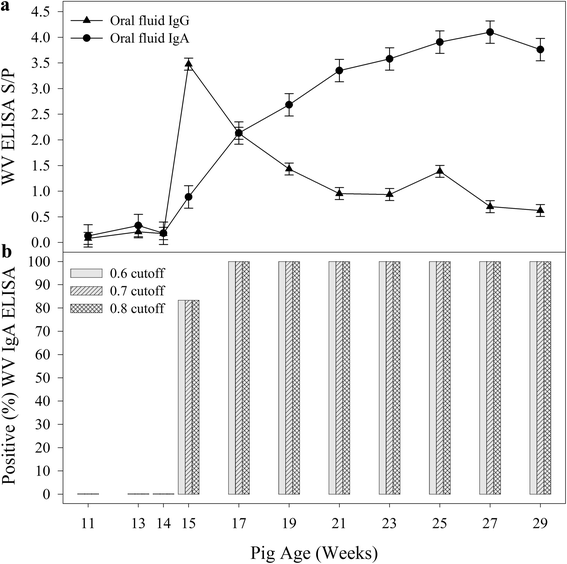Porcine epidemic diarrhea virus (PEDV) detection and antibody response in commercial growing pigs
- PMID: 27287624
- PMCID: PMC4902975
- DOI: 10.1186/s12917-016-0725-5
Porcine epidemic diarrhea virus (PEDV) detection and antibody response in commercial growing pigs
Abstract
Background: Longitudinal samples from two production sites were used to (1) describe the pattern of PEDV shedding (rRT-PCR) in individual rectal swabs, pen fecal samples, and pen oral fluids (OF); (2) describe the kinetics of PEDV antibody by ELISA (IgA, IgG) testing of pig serum and pen oral fluid samples; and (3) establish cutoffs and performance estimates for PEDV WV ELISAs (IgA, IgG). Site One was PEDV positive; Site Two was PEDV negative. On Site One, pen samples (feces and oral fluids) and pig samples (rectal swabs and sera) were collected both before and after the population was exposed to PEDV.
Results: On Site Two, pen oral fluid samples and individual pig serum samples were negative for both PEDV antibody and nucleic acid. On Site One, PEDV was detected by rRT-PCR at 6 days post exposure (DPE) in all sample types. The last rRT-PCR positives were detected in rectal swabs and oral fluids on 69 DPE. IgG and IgA were detected in oral fluids and serum samples by 13 DPE. Analysis of the PEDV serum IgG WV ELISA data showed that a sample-to-positive (S/P) cutoff of ≥ 0.80 provided a diagnostic sensitivity of 0.87 (95% CI: 0.82, 0.91) and specificity of 0.99 (95% CI: 0.98, 1.00). Serum IgG results declined slowly over the monitoring period, with 60% of serum samples positive (S/P ≥ 0.80) at the final sampling on 111 DPE. Analysis of the PEDV oral fluid IgA WV ELISA found that a cutoff of S/P ≥ 0.80 provided a diagnostic sensitivity of 1.00 (95% CI: 0.92, 1.00) and a diagnostic specificity of 1.00 (95% CI: 0.99, 1.00). The oral fluid IgA response increased through 96 DPE and began to decline at the last sampling on 111 DPE.
Conclusions: This study showed that oral fluid-based testing could provide an easy and "animal-friendly" approach to sample collection for nucleic acid and/or antibody-based surveillance of PEDV in swine populations.
Keywords: Antibody kinetics; IgA; IgG; Oral fluids; PEDV; Surveillance; Virus shedding.
Figures



References
-
- Saif LJ, Pensaert MB, Sestak K, Yeo S, Jung K. Coronaviruses. In: Zimmerman JJ, Karriker LA, Ramirez A, Schwartz KJ, Stevenson GW, editors. Diseases of Swine. 10. Ames: Wiley and Sons; 2012. pp. 501–524.
Publication types
MeSH terms
Substances
LinkOut - more resources
Full Text Sources
Other Literature Sources
Research Materials
Miscellaneous

